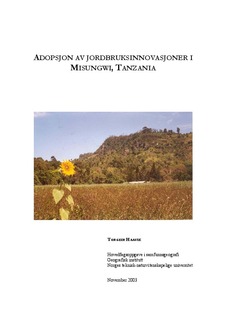Adopsjon av jordbruksinnovasjoner i Misungwi, Tanzania
Master thesis

Åpne
Permanent lenke
http://hdl.handle.net/11250/2373065Utgivelsesdato
2003Metadata
Vis full innførselSamlinger
- Institutt for geografi [1119]
Sammendrag
This thesis is the result of investigations of the agricultural practices in Misungwi district in
Tanzania. The background for the research is the rough conditions for agriculture in the
district and an assumption that new practices can lead to better results in the form of increased
harvests and reduced work load. Many practices are currently being introduced to a large
number of farmers in Misungwi through a project intervention by CARE.
The central objective of the thesis is to identify and discuss barriers and incentives for
adoption of innovations among the farmers. As part of this objective, the agricultural system
in terms of agroclimatic conditions, types of crops, work methods, and income- and market
conditions will also be explored. And of course, the mere mapping of existing innovations is
central.
Several methods have been used for the data production and collection, in accordance with the
concept of triangulation; interviews, informal talks, participatory observation and secondary
literature are the main sources of information. Also, I have used different theories in the
evaluation process, in order to see the information from several angles. These include, among
others, classical diffusion theories, social characteristics of adopters and more recent views
upon technologies as social constructed complexes.
Through my inquiries, I have identified a set of central practices, to which the many farmers
relate different with respect to use. Among these practices are such implements as modern
seeds, natural pesticides and the treadle pump, but also processual innovations such as
formation of interest- and work groups. The research undertaken reveals that the rate of
adoption of these practices is related to several different barriers and incentives. One of the
barriers is the distance between the village where the farmers live, and Mwanza city. In other
words, high centrality is positively correlated with the use of many of the investigated
practices. Other barriers to adoption include price of implements, lack of knowledge about the
practices, availability of the relevant implements and their suitability.
The central incentive for adoption is a positive cost-benefit analysis. There is also a positive
correlation between membership in CBOs and the rate of adoption. In addition to this, the
actual intervention of an NGO, in this case CARE, has a substantial effect on the adoption rate.
Whether the rate of adoption will stay high after the project ends, is still an open question.